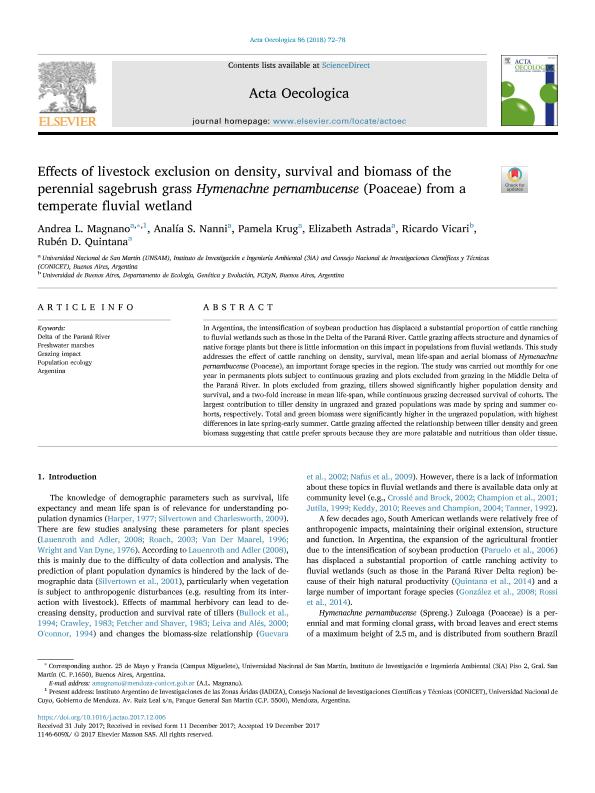Artículo
Effects of livestock exclusion on density, survival and biomass of the perennial sagebrush grass Hymenachne pernambucense (Poaceae) from a temperate fluvial wetland
Magnano, Andrea Laura ; Nanni, Analía Soledad
; Nanni, Analía Soledad ; Krug, Cecilia Pamela
; Krug, Cecilia Pamela ; Astrada, Elizabeth Nora
; Astrada, Elizabeth Nora ; Vicari, Ricardo; Quintana, Ruben Dario
; Vicari, Ricardo; Quintana, Ruben Dario
 ; Nanni, Analía Soledad
; Nanni, Analía Soledad ; Krug, Cecilia Pamela
; Krug, Cecilia Pamela ; Astrada, Elizabeth Nora
; Astrada, Elizabeth Nora ; Vicari, Ricardo; Quintana, Ruben Dario
; Vicari, Ricardo; Quintana, Ruben Dario
Fecha de publicación:
01/2018
Editorial:
Gauthier-Villars/Editions Elsevier
Revista:
Acta Oecologica
ISSN:
1146-609X
Idioma:
Inglés
Tipo de recurso:
Artículo publicado
Resumen
In Argentina, the intensification of soybean production has displaced a substantial proportion of cattle ranching to fluvial wetlands such as those in the Delta of the Paraná River. Cattle grazing affects structure and dynamics of native forage plants but there is little information on this impact in populations from fluvial wetlands. This study addresses the effect of cattle ranching on density, survival, mean life-span and aerial biomass of Hymenachne pernambucense (Poaceae), an important forage species in the region. The study was carried out monthly for one year in permanents plots subject to continuous grazing and plots excluded from grazing in the Middle Delta of the Paraná River. In plots excluded from grazing, tillers showed significantly higher population density and survival, and a two-fold increase in mean life-span, while continuous grazing decreased survival of cohorts. The largest contribution to tiller density in ungrazed and grazed populations was made by spring and summer cohorts, respectively. Total and green biomass were significantly higher in the ungrazed population, with highest differences in late spring-early summer. Cattle grazing affected the relationship between tiller density and green biomass suggesting that cattle prefer sprouts because they are more palatable and nutritious than older tissue.
Archivos asociados
Licencia
Identificadores
Colecciones
Articulos(IADIZA)
Articulos de INST. ARG DE INVEST. DE LAS ZONAS ARIDAS
Articulos de INST. ARG DE INVEST. DE LAS ZONAS ARIDAS
Articulos(SEDE CENTRAL)
Articulos de SEDE CENTRAL
Articulos de SEDE CENTRAL
Citación
Magnano, Andrea Laura; Nanni, Analía Soledad; Krug, Cecilia Pamela; Astrada, Elizabeth Nora; Vicari, Ricardo; et al.; Effects of livestock exclusion on density, survival and biomass of the perennial sagebrush grass Hymenachne pernambucense (Poaceae) from a temperate fluvial wetland; Gauthier-Villars/Editions Elsevier; Acta Oecologica; 86; 1-2018; 72-78
Compartir
Altmétricas



